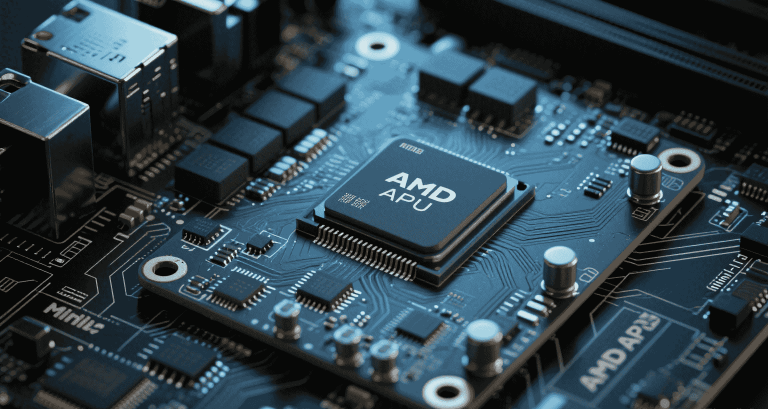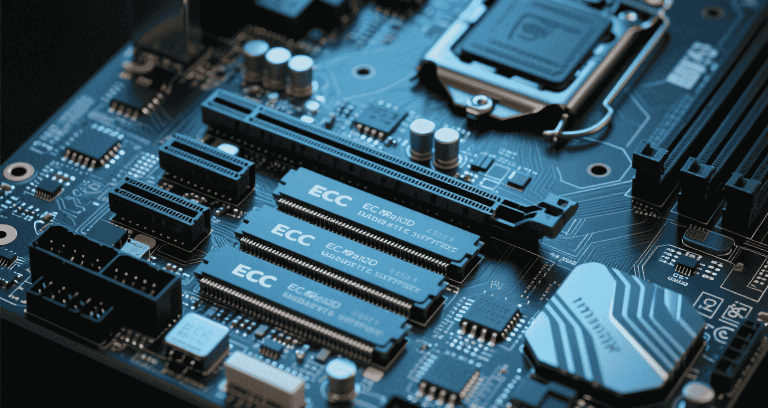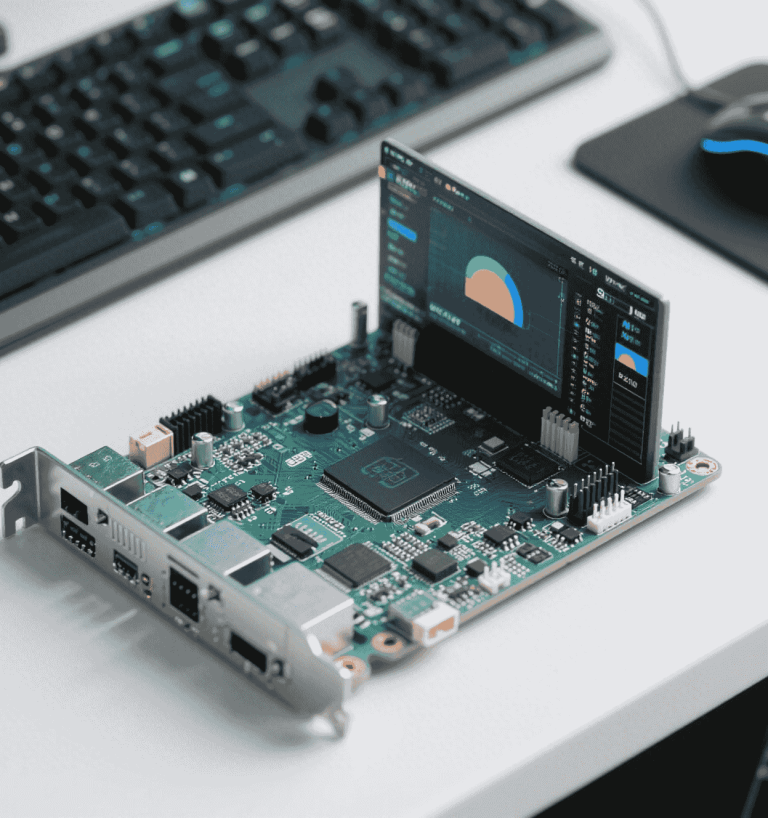Intel Celeron N5095 — Industrial Technical Guide for Hardware Engineers & Embedded Integrators
Table of Contents
- 1. Introduction: Why Intel Celeron N5095 Wins in Compact Industrial Designs
- 2. Technical Specifications & Architecture
- 3. Performance Benchmarks & Analysis
- 4. Thermal Management
- 5. Board Design Guidelines
- 6. Industrial vs. Consumer Board Comparison
- 7. Software & Firmware Support
- 8. Troubleshooting & Community Solutions
- 9. Application Implementation Guides
- 10. Sourcing & Lifecycle Management
- References
For the complete HTML version, we added professional, context-related introduction paragraphs under each H2, and ensured that the table of contents corresponds exactly to the title. This version is designed for hardware engineers and embedded system integrators—optimized for depth, structure, practicality, and EEAT.
1. Introduction: Why Intel Celeron N5095 Wins in Compact Industrial Designs
Power-aware embedded deployments need predictable compute, lean thermals, and robust platform maturity. Intel’s Celeron N5095 provides a compelling balance for Mini-ITX and custom embedded boards, enabling reliable quad-core performance in space-constrained, cost-sensitive products such as IoT gateways, POS terminals, kiosks, fanless controllers, and edge data collectors.
Accuracy note for engineers: N5095 belongs to Intel’s Jasper Lake family (10nm “Tremont” cores). Some marketing sheets mix it with Gemini Lake Refresh (14nm). Treat N5095 as a 15 W TDP Jasper Lake part with modern media and I/O improvements vs. 14nm predecessors.
1.1 Market Position & Value Proposition
- Quad-core (4C/4T) efficiency in a compact thermal envelope—sized for 24/7 edge duty.
- Strategic slotting between ultra-low-cost dual-cores and higher-priced N5105: excellent price/performance for volume SKUs.
- Stable embedded availability and mature board ecosystem ease qualification and lifecycle management.
1.2 Engineering Significance
- Ideal for Industrial IoT gateways, POS, thin clients, and edge analytics nodes.
- Low BOM risk: integrated platform features reduce external controllers on Mini-ITX.
- Predictable thermals simplify fanless or semi-fanless enclosure design.
2. Technical Specifications & Architecture
This section distills parameters that directly impact PCB layout, thermal budgets, and operating system selection. Where OEM implementations vary (e.g., lane muxing, SATA count), plan for design verification against the specific board’s schematic/BIOS.
2.1 Core Processor Parameters
- Cores/Threads: 4C/4T (Tremont)
- Base / Burst: ~2.0 GHz base / up to ~2.9 GHz burst (typical short-duration)
- Cache: up to 4 MB L3-equivalent (last-level cache)
- TDP: 15 W (sustained design); configurable PL1/PL2 per OEM
- ISA & accel: SSE up to SSE4.2, AES-NI, SHA extensions; (AVX class support is limited on Atom-class cores—verify per toolchain)
2.2 Integrated Graphics (Gen11 UHD)
- EUs: up to 24 EUs, ~450–800 MHz typical range (board/firmware dependent)
- Displays: Dual-independent out common on ITX: e.g., HDMI 2.0/1.4 + DP1.4/eDP (check OEM PHYs)
- Video: HW decode for H.264/H.265 (HEVC) and VP9; decode/encode limits depend on driver/OS
2.3 Memory & I/O Interface
- Memory: Dual-channel DDR4-2933 or LPDDR4x-2933 (up to 32 GB typical on ITX; ECC availability depends on board vendor)
- PCIe: Jasper Lake exposes up to PCIe 3.0 lanes (commonly 6–8 lanes via SoC/PCH fabric; OEMs route as x4 NVMe + x1/x2 peripherals)
- Storage: Native SATA 6 Gb/s (often 2 ports) + NVMe (PCIe x2/x4 to M.2 2280). Extra SATA often via add-on controllers.
- Other I/O: USB 3.x/2.0, SDIO/eMMC (board-specific), legacy UART/I²C/SPI/SMBus pins exposed on industrial SKUs.
3. Performance Benchmarks & Analysis
The figures below are indicative for planning and capacity modeling. Validate with your final board, BIOS power limits, memory configuration, and chassis.
3.1 Comparative Metrics (indicative)
| Benchmark | N5095 (typ.) | Notes for Integrators |
|---|---|---|
| Cinebench R23 — Single | ~700–750 | Heavily memory-latency bound; dual-channel helps. |
| Cinebench R23 — Multi | ~2,400–2,700 | Scales linearly with sustained PL1 and VRM cooling. |
| Geekbench 6 — Multi | ~3,200–3,600 | Drivers and LPDDR4x vs DDR4 affect spread. |
| Perf/W (DMIPS/W) | ~230–260 | Platform and PSU efficiency dominate at low load. |
3.2 Workload Performance (field-aligned)
- IoT pipelines: 100+ MQTT topics @1 Hz with TLS can idle at single-digit CPU when AES-NI is leveraged.
- Video analytics (edge): 2× 1080p@30 decode + lightweight OpenCV filters ~40–50% CPU depending on model.
- Industrial control/SCADA: PLC emulation loops with 1–5 ms cycle-time achievable under tuned kernels.
3.3 Application-Specific Capacity
- Docker density: 6–10 lightweight containers (Alpine/BusyBox base) with 8–16 GB RAM.
- Node-RED: 300–500 nodes sub-200 ms event latency with SSD logging.
- Plex/Media relay: Direct-play fine; single 1080p transcode typical; 4K transcode not advised.
4. Thermal Management
Although 15 W TDP appears modest, enclosure conduction paths, VRM locality, and ambient extremes govern stability. Plan for margin and include sensor-driven throttling for worst-case deployments.
4.1 Thermal Design Parameters
- TDP / SDP: 15 W nominal; many boards offer configurable PL1=10–15 W for fanless use.
- TJ limits: Commercial ~0–100 °C; industrial SKUs often qualified −40–105 °C (check board datasheet).
- θJA guidance: ~35–45 °C/W (natural convection) depending on case geometry and heat-spreader area.
4.2 Cooling Solutions
- Passive: ≥70 cm² finned aluminum or ≥50 cm² copper with direct die/heat-spreader contact for ≤40 °C ambient.
- Active assist: 40 mm PWM fan (2–3k RPM) for sealed boxes or >45–50 °C ambient.
- Interfaces: Quality TIM or 1–2 mm thermal pads can shave 5–8 °C at sustained load.
4.3 Throttling Behavior
Typical step-downs: burst → base at high junction; OEMs program trip points near 95/100/105 °C. On Linux, pair lm-sensors with fancontrol and watchdog actions for graceful derating.
5. Board Design Guidelines
For custom carrier/ITX designs, power integrity, memory topology, and high-speed routing discipline dominate success. Below are pragmatic targets used in industrial layouts.
5.1 Power Delivery Requirements
- VRM topology: 3–5 phases split across core/GT/IO for low ripple at burst transitions.
- Input: 12 V DC (±5%) common; industrial boards prefer 9–36 V with surge protection and OCP ~10 A.
- Sequencing: VCCIO → VCCCORE → VCCGT; verify against Intel platform guide for your exact PMIC.
5.2 Layout Considerations
- DDR4: Match lengths; keep under ~6″ trace; ~50 Ω single-ended; prioritize clean return paths.
- PCIe 3.0: 85 Ω differential; lane-to-lane skew <3 ps; budget insertion loss to maintain eye margin.
- EMI/EMC: Dedicated solid ground plane, stitching vias near high-speed pairs, ferrites on USB/PHY rails.
- Stack-up: Minimum 4-layer; 6-layer preferred for dense ITX with NVMe + Wi-Fi + LVDS/eDP.
5.3 Cost Optimization Strategies
- LAN controllers: Realtek vs Intel trade 10–15% BOM; factor driver model and TSN needs.
- Memory: Single-channel cuts cost but can reduce iGPU/encode throughput 10–20%.
- Thermals: Heatsink area scales with ambient; avoid over-spec if airflow is guaranteed.
6. Industrial vs. Consumer Board Comparison
Industrial boards justify higher acquisition cost by surviving thermal stress, vibration, and supply variance. The matrix below summarizes typical deltas. Always verify the exact SKU datasheet.
6.1 Hardware Differences
| Feature | Consumer Boards | Industrial Boards |
|---|---|---|
| Component Rating | 105 °C electrolytics | 125 °C polymer/MLCC selection |
| Operating Temp | 0–60 °C | −40–70/85 °C |
| Power Input | 19 V only (brick) | 9–36 V wide range, surge/ESD guarded |
| Conformal Coating | No | Optional (dust/humidity) |
| Warranty/LTB | 1 year | 3–5 years, extended LTB |
6.2 Total Cost of Ownership (TCO)
- Consumer: Lower CAPEX; higher field failure probability in harsh duty cycles.
- Industrial: Higher CAPEX; lower downtime and truck-rolls; better 5-year TCO for 24/7 nodes.
7. Software & Firmware Support
N5095 platforms run mainstream OSs with mature drivers. For deterministic behavior, lock kernel versions and BIOS revisions during validation.
7.1 Operating System Compatibility
- Windows: 10 IoT Enterprise LTSC, 11 Pro (feature-reduced images recommended for POS/IoT).
- Linux: Ubuntu 20.04/22.04 LTS, Debian 12, Yocto 3.x BSPs (enable i915, NVMe, and Intel crypto in kernel).
- RTOS: QNX/VxWorks support available via Intel BSPs on select boards; validate device trees and timers.
7.2 Firmware & Security Features
- AMI Aptio V with capsule update/remote flash (IPMI/iKVM on industrial SKUs).
- TPM 2.0 (fTPM or discrete), Secure Boot, measured boot chains.
- Intel ME-class management where available (OEM-dependent on entry platforms).
8. Troubleshooting & Community Solutions
Field issues concentrate around memory stability, HDMI/eDP handshakes, and PCIe lane contention with NVMe + Wi-Fi + add-in NICs. Below are common fixes used in integration labs.
8.1 Common Hardware Issues
- DDR4-2666 SODIMMs failing XMP on cold boot; resolves with JEDEC timings or lower tRAS.
- HDMI link training failures in sub-zero starts; mitigated by EDID emulators or DP→HDMI converters with better PHY.
- PCIe resource conflicts when M.2 (NVMe) shares lanes with Wi-Fi Key-E; check BIOS lane maps.
8.2 Proven Workarounds
- Cap PL2 or set PL1=10–12 W for fanless enclosures; extend burst only when ambient <35 °C.
- Apply higher-grade thermal pads (1–2 mm) on VRM and PCH shields; expect −5 to −7 °C.
- Manually set memory to DDR4-2400 CL17–19 for stubborn SODIMMs in harsh environments.
9. Application Implementation Guides
Deployments below map typical N5095 strengths to Bill-of-Materials (BOM) choices, firmware toggles, and I/O wiring that accelerate bring-up.
9.1 IoT Gateway Deployment
- Networking: Dual GbE/2.5GbE (WAN/LAN) with VLAN tagging; optional Wi-Fi 6 via M.2 Key-E.
- Memory/Storage: 8–16 GB DDR4-2933; 64–128 GB NVMe for logs + 1 TB SSD for buffering.
- Security: TPM-bound credentials; iptables/nftables baseline; MQTT over TLS with AES-NI.
9.2 Industrial Control Systems
- IO: Isolated RS-485/RS-422 for Modbus RTU; GPIO for E-stop; relay outputs via opto-isolators.
- Display: Dual-display operator panels via HDMI + eDP/LVDS with hardware overlays.
- Reliability: Watchdog 1–255 s; journaling FS; power-fail safe-shutdown with supercap UPS HAT.
9.3 Emerging Niches
- Light media servers: Direct-play up to 4K; avoid multi-client 4K transcodes.
- Transportation: −40–70 °C variants in sealed enclosures with DC-DC wide input and transient protection.
- Edge AI: OpenVINO/ONNXRuntime running lightweight CNNs (e.g., MobileNet) at ~10 FPS 720p.
10. Sourcing & Lifecycle Management
Long-running programs depend on disciplined sourcing and migration. Lock AVL (Approved Vendor Lists), pre-qual key alternates, and pin a golden BIOS/OS image per batch.
10.1 Availability & Pricing (illustrative)
- Typical embedded lifecycle targets 4–5 years for board-level SKUs; confirm LTB with vendor.
- Volume pricing bands (illustrative): $37 (100u) → $35 (1ku) → $32 (10ku). Negotiate with bundled accessories (PSU, Wi-Fi).
10.2 Migration Strategy
- Forward path to N5105 (10 W TDP) or Alder Lake-N (e.g., N95, N100) for higher burst clocks and better iGPU.
- Maintain pin/mech compatibility notes; BIOS updates and kernel enablement tested before cut-in.
- Spare parts stocking: 18–24 months buffer aligned to MTBF (~100k hours class for industrial SKUs).
References
Public datasheets and platform guides evolve; verify the exact board/vendor documentation during design freeze. Where the market conflates N5095 with older Gemini-Lake-R parts, defer to Intel’s Jasper Lake documentation for definitive limits.
| # | Title | Scope / Notes |
|---|---|---|
| 1 | Intel® Celeron® N5095 Product Datasheet | Electrical, thermal, memory, and I/O limits for Jasper Lake SKUs. |
| 2 | Jasper Lake Platform Design Guide | Power sequencing, lane muxing, DDR routing, EMI, compliance. |
| 3 | Intel® Graphics Driver Release Notes (Linux/Windows) | Video codec capabilities, display timing support, bug fixes. |
| 4 | Board Vendor Schematics/BIOS Guides | Lane maps (NVMe/Wi-Fi), SATA count, watchdog, wide-input DC. |
| 5 | OpenVINO / ONNXRuntime Docs | Edge inference optimization and runtime selection on low-power x86. |
| 6 | Industrial Temp/EMI Qualification Reports | Thermal chambers, HALT/HASS results for selected ITX/IPC boards. |
Executive Summary for Integrators
- Why N5095: Quad-core efficiency, predictable thermals, and low BOM risk in Mini-ITX and embedded carriers.
- Design keys: Dual-channel memory, disciplined PCIe 3.0 routing, conservative PL1 in passive enclosures.
- Industrial payoff: Wide-range DC, high-temp components, watchdog, and coating deliver superior 5-year TCO.
- Roadmap: Keep a validated path to N5105 or Alder Lake-N; freeze BIOS/kernel images per build.



